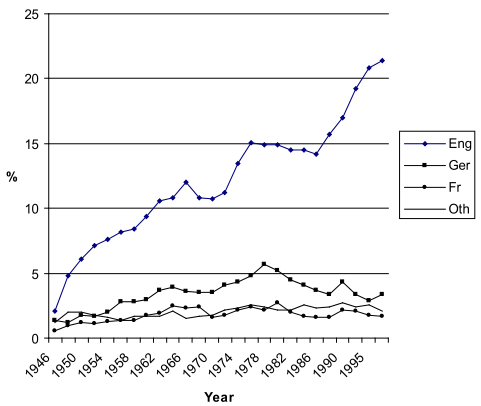- 簽證留學(xué) |
- 筆譯 |
- 口譯
- 求職 |
- 日/韓語 |
- 德語
The different source languages can be seen as an indication of the cultural capital of the linguistic group in question and the country’s prevailing geo-cultural orientation. The usual way to present such data is by calculating the number of translations from a
certain language over the total number of translations. If we distinguish four language groups (English, German, French, and Other Languages), it is evident that, for example, the share of translations from English has increased from nearly 40% (1946) to 75% (1997). In part as an immediate consequence of the growth of translations from English, the percentages for the other three language groups were in decline. However, the problem with this mode of presenting data is that indigenous books are left out of the equation, suggesting that translation is a zero-sum game. Translations compete not only with other translations, but also with books in the native language. It would be more accurate to calculate the proportion of translations from the four language groups as a
percentage of the total number of books. Dutch books then become part of the competition. The pattern that emerges (see Figure 1) differs in various respects from the common mode of presentation. Instead of an overall decline in translations from languages
other than English, there is a highly uneven but general growth of translations until approximately 1980. Growth was obviously stronger for English translations, which increased from 2% to 15% of the total number of books in 1976. But the share of translations from other languages also increased. German translations expanded from 1.4% (1946) to nearly 6% (1980), French increased from 0.6 to 2.7% (1980), and translationsTranslations from English, German, French and from Other Languages went up from 1.2 to 2.6% (1984).

Figure 1. Translations from English, German, French and other languages as a percentage of the total number of Dutch books (1946–1997)
Although English gained an enormous advantage over its competitors, book translations from German, French, and other languages also improved their share. Translations during these decades were on the whole more in favor than were Dutch books. From 1976 to 1986, during the economic downturn, this trend was reversed. There was a general decline: translations from German declined from 5.7% (1978) to 3.4% (1997), translations from French from 2.7% (1980) to 1.7% (1997), translations from Other Languages from 2.6% (1984) to 2.1% (1997). For a while even translations from English decreased slightly: from 15.1% (1976) to 14.2% (1986). But English was the only language that recovered: from 1986 to 1997 its share increased further, from over 14% to 21%.
The corresponding data are not available for the period after 1997. Comparable data, however, can be obtained from the Royal Library in The Hague. Although the figures are less selective than those used for the period 1946–1997, they unambiguously confirm the abovementioned trends. During the years 1990–2002, translations from English have increased both in absolute numbers and as a proportion of the total number of books: from almost 14% to almost 20% (Van Rees 2004). The decline in translations from French is stronger than the previously cited data indicate (from 2.9% to 1.6%), translations from German remain stable in absolute numbers but regress proportionally (from 3.5 to 2.8 %), while translations from other languages increase in absolute numbers but remain proportionally stable at around 2% of the national book production.
On the basis of this analysis, it seems clear that the economic crisis of the 1980s had a cultural component. Prior to that period, the share of translations from each of the four language groups had increased as a proportion of the number of books published. English was by far the most important foreign language, but the shares of German and French also increased. After the crisis of the 1980s, a cultural reorientation seems to have taken place: publishers further increased the proportion of translations from English while diminishing translations from French and German. Since these statistics concern all categories of books, not just literary translations, the explanation must be relatively general. The 1980s and 1990s were a period of important geopolitical shifts. European integration accelerated and the antagonism between Western democracies and Communist states first weakened and then disappeared, leaving the US as the only superpower. Both processes have reinforced the international position of English. While this is evident for “globalization” after the fall of Communism, it is also the case for European integration. The very plurality of languages in the European Union strengthened the call for a lingua franca, for which English was the best candidate. As Abram de Swaan demonstrated in his analysis of the European language system, the more languages, the more English (De Swaan 2001, Chapter 8).
責(zé)任編輯:admin
